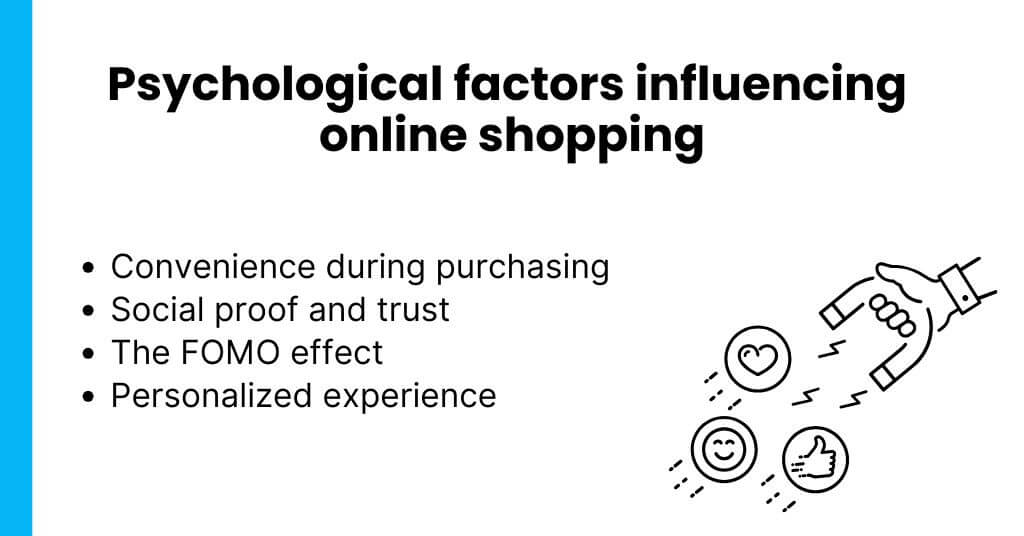The psychology of shopping is a trendy discipline that has gained much attention. Today, some companies invest significant funds in discovering their customers’ psychology.
Understanding how consumers find and choose products helps ecommerce businesses in increasing sales. To do this, companies must recognize the fundamentals of the psychology of online buying and exactly how this varies from physical shop buyer choice-making.
The basic principles of applied consumer psychology are adaptable and can help ecommerce businesses increase income, no matter the size. Let’s see the fundamentals of the psychology behind online shopping.
The origin of consumer psychology #
Consumer psychology and behavior are entrusted with determining:
- What people want to buy. Understanding what people want to buy starts with their needs, desires, and current trends. Consumers go toward products that solve problems, improve their lives, or fulfill aspirations.
- Why do people wish to buy it. The motivations behind a purchase can be emotional, logical, or a mix of both.
- What makes the distinction between an abandoned cart and an effective purchase. The line between cart abandonment and completing a purchase often boils down to three factors: trust and clarity, ease of checkout, and shipping terms.
- How to incentivize the customer journey to raise sales. Encouraging customers to move seamlessly through their journey involves strategic nudges and value-added offers like recommendations, loyalty programs, etc.
Consumer psychology had its roots in the early 20th century when researchers began to study the behavior of consumers and how it relates to marketing.
One of the pioneers of consumer psychology was Walter D. Scott. In 1903, he published “The Theory of Advertising,” a seminal work exploring the psychological factors influencing consumer behavior. John B. Watson was another influential figure in the early history of consumer psychology. Watson believed that advertising could be used to drill consumers to associate products with positive emotions and experiences, leading to increased sales.
Since then, consumer psychology has grown and evolved. Researchers are getting into the workings of the human mind and how it relates to decision-making, motivation, and emotion.
Today, consumer psychology is used to significant impact by widely known brands across all types of particular niches and sectors.
Netflix is among the most important and best-known businesses that incorporated consumer psychology into their platform. How do they keep visitors engaged and return for even more?
The application of consumer psychology is responsible for auto-play countdowns, following episodes of the show, and detailed thumbnails for every show. These features are personalized to interest various visitors and might differ from user to user.
Shopping behavior and psychology #
Shopping is a complex process that is influenced by a variety of psychological factors. Understanding these factors can help businesses create more effective strategies that cater to consumer needs. Let’s see what makes consumers click that ‘buy now’ button.
Convenience of online shopping #
One of the main reasons why online shopping has become so popular is its convenience. Online shopping allows consumers to browse and purchase products from their homes. According to a survey by Statista, 62% of global consumers said convenience is the primary reason for online shopping.
People are more likely to choose options that require less effort, which is why online shopping has become a go-to option for many consumers.
Social proof may trigger a purchase #
Humans are naturally influenced by others. Social proof is a powerful psychological principle that refers to people’s tendency to follow others’ actions and opinions. In the context of online shopping, social proof is a crucial factor that influences consumer behavior.
According to a survey by BrightLocal, 85% of consumers trust online reviews as much as personal recommendations.
For example, when consumers see that other people have purchased and left a review, they are likelier to buy that product themselves. This is why customer reviews and ratings are important in online shopping, and they provide social proof that the product is worth buying and can help build trust between the consumer and the business.
Reviews, testimonials, and trust badges work because they reassure potential buyers that others have had positive experiences. For CRO, displaying “Most Popular” or “Best Seller” tags, highlighting customer ratings, or adding “500+ happy customers” builds confidence and reduces decision-making anxiety.
FOMO and online shopping #
FOMO (Fear of Missing Out) is a powerful psychological motivator that drives consumers to make purchases. Marketing with FOMO can significantly contribute to increasing the willingness to buy. Limited-time offers, flash sales, and other time-sensitive promotions are all examples of FOMO implications in online shopping. If a customer is about to make a purchase, such authentic offers and recommendations can increase sales at the right moment.
By creating a sense of urgency, businesses can tap into consumers’ FOMO and encourage them to purchase. In FOMO marketing, it is important to make the feeling that if you don’t buy now, you will regret it later.
According to a survey by RetailMeNot, 68% of consumers have made an unplanned purchase because of a sale, and 74% have completed a spontaneous purchase because of FOMO.
Personalization as one of the most influential factors #
Using data analysis, brands can offer personalized experiences and product recommendations. If combined with FOMO, exclusivity becomes even more powerful.
Personalization is essential to shoppers because it makes the shopping experience more enjoyable and convenient. Also, it helps consumers discover products they might not have found otherwise.
A sense of exclusivity makes consumers feel valued. With artificial intelligence (AI), automation, and marketing personalization, brands can customize shopping experiences to fit customers’ interests based on shopping data. Examples of personalization in online shopping include recommended products based on past purchases or browsing history, personalized offers and discounts, and personalized content (newsletters, recommendations).
Consumers appreciate trust #
With so many businesses operating online, consumers need to be able to trust the companies they are dealing with. Consumers’ trust in a product is an important factor in online shopping. Trust-building elements and reliability can help businesses attract and retain customers.
Trust-building elements in online shopping include security badges and certifications, reviews, clear and transparent policies, and responsive customer service. Consumers rely on review content and the number of reviews and ratings to help in making purchase decisions (Riasanow et al. 2015).
Building customer trust is a continuous process that requires ongoing attention and effort. Creating a sense of confidence and credibility can help brands to succeed in the competitive world of online shopping.

The similarities and differences between online and offline sales psychology #
Integrating psychology into online marketing differs from managing a consumer’s journey through a real-world store. For example, offline sales channels use sensory techniques to drive customers, which is impossible in online shopping. But the core principles remain the same.
The key to the practical usage of shopper behavior with consumer psychology has its roots in finding out what shoppers want. It can also help create a message, tone, and impression that reinforces the perception of a particular online store.
Let’s imagine a brand that sets its routes within the store to maximize the distance a shopper walks and the number of products and incentives they are exposed to. The same effect can be applied to the online store by having the following:
- Suggestions of alternative or complementary products within the product pages,
- Tips on what other people have viewed or bought,
- Navigation options that take the consumer on a journey through the different facets of a webshop.
However, making the webshop hard to navigate or forcing the visitors to follow a set route is only achievable partially online. It will lead to checkout abandonment and frustrated buyers, and it is because they can click away from a competitor rather than trying to figure out how to finish the purchase.
Consumer behavior tactics can be integrated into a webshop at every stage, from the design, color scheme, and navigation to each product description.
Knowing the audience demographics is just the beginning and provides the foundation building blocks for increasing sales. This principle is shared between real-world and virtual stores, but how this information is applied in practice is very different when targeting online audiences.
Getting store’s theme and color scheme right #
The appearance and impression given by an online store have as much impact on online consumer behavior as it does on offline businesses. The website’s theme and color scheme should be planned to appeal to the target demographics and support sales. 93% of buyers focus on the visual appearance of the products they are considering and the store they are browsing for them in. That’s why color psychology is very popular among web designers.
Bright, bold colors generate a sense of energy and momentum. In contrast, pastel or muted tones generate a relaxed or calming impression.
If the company is trying to market to impulse buyers and shoppers ready to purchase now, generating a sense of urgency with bright, bold shades and incentives will work best. In addition, if the business wants to engage shoppers who can purchase multiple goods or high-value items, something calmer and more relaxing, such as blue shades, would probably be a better fit.
Taking the customer perception #
Viewing the individual webshop experience with the eyes of the consumers can assist the company in recognizing potential troubles or losses throughout the sales funnel, thus allowing it to determine and mitigate imperfections and issues.
Usually, many entrepreneurs will have a relatively biased view of their website’s allure and functionality. This can introduce implicit predisposition and make seeing issues preventing buyers from completing an acquisition more challenging. It is essential to take this impact into account.
An ecommerce business should look at its competitors and see if it can determine things they do well or poorly. Furthermore, using the website’s analytics and information records can help determine how buyers browse the website and where they leave it. Pinpointing where visitors lose their emotional commitment to purchasing is crucial for increasing ecommerce sales.
Psychology behind online shopping summed up #
Understanding the psychology behind online shopping can be helpful to ecommerce businesses.
The convenience of online shopping, social proof, FOMO, personalization, and building customer trust are some of the essential psychological factors influencing online shopping behavior.
Applying effective strategies catered to the customers’ needs may lead to increased sales and customer loyalty.
Do you want to learn more about ecommerce? Continue reading about → Gamification.

